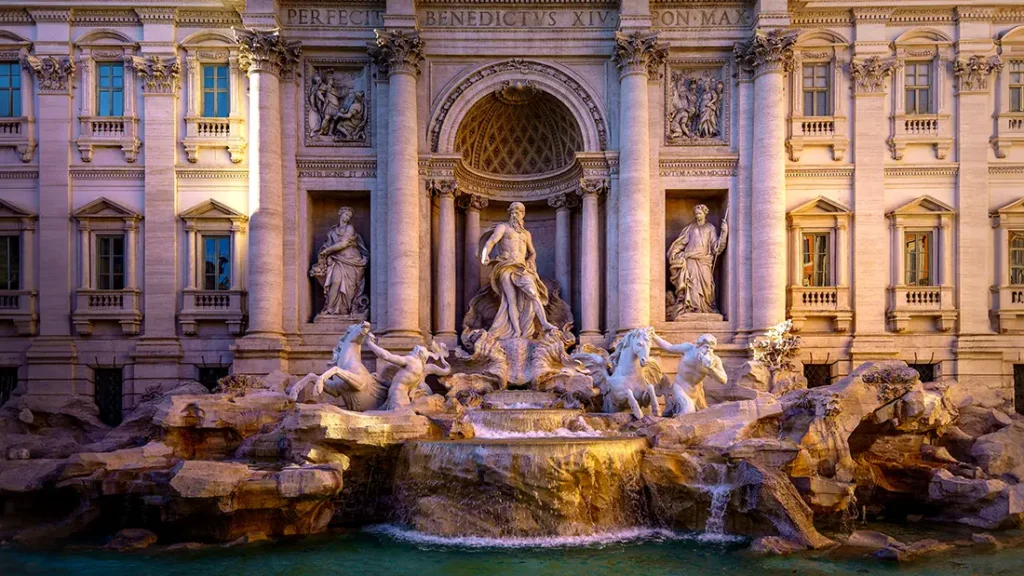
The Trevi Fountain in Rome is one of the most iconic landmarks in the world, attracting millions of visitors each year. Known for its grand design, mesmerizing sculptures, and the tradition of throwing a coin for good luck, the fountain holds a special place in both the hearts of travelers and the annals of history.
However, beyond its famous exterior lies a fascinating underground secret that adds another layer of intrigue to its already rich history. Let’s dive into the Trevi Fountain’s legacy and its hidden mystery below the surface.
The Trevi Fountain: A Roman Masterpiece
1. The History Behind the Trevi Fountain
The Trevi Fountain, or “Fontana di Trevi” in Italian, was designed by architect Nicola Salvi and completed by Giuseppe Pannini in 1762.
It was commissioned by Pope Clement XII as part of a renovation project for the ancient Aqua Virgo aqueduct, which had supplied water to Rome since the Roman Empire.
The fountain’s elaborate design, combining Baroque art with classical themes, has made it a favorite among both locals and tourists.
The fountain’s central figure is Neptune, the Roman god of the sea, riding a chariot pulled by two horses. One horse is calm, while the other is wild, symbolizing the contrasting moods of the sea.
The water flowing from the fountain is a tribute to the ancient aqueduct, which provided clean water to Rome for over 2,000 years.
2. The Famous Coin Tradition
One of the most well-known aspects of the Trevi Fountain is the tradition of throwing a coin into its waters. According to popular belief, throwing a coin over your left shoulder while facing away from the fountain guarantees a return trip to Rome. This practice has become a staple of the tourist experience, with an estimated 3,000 euros thrown into the fountain each day, contributing to the city’s charitable causes. The tradition has not only added to the magic of the Trevi Fountain but has also reinforced its status as a must-see destination.
The Underground Secret of the Trevi Fountain
1. A Hidden Roman Mystery
While the Trevi Fountain’s surface splendor is undeniable, few know that beneath it lies a hidden historical secret. The area surrounding the fountain is built over the ruins of ancient Roman structures, including the remains of the ancient Roman “embassy” of the Quirinal Hill.
In addition to these ruins, beneath the fountain lies an underground water basin that has been part of the city’s water system for centuries.
This underground water system, connected to the Aqua Virgo aqueduct, was a crucial part of how the ancient Romans supplied water to their public baths and fountains.
The basin, which is not typically visible to the public, still functions as part of the water supply for the Trevi Fountain. In fact, water from this basin continues to flow through the fountain today, maintaining the ancient legacy of Rome’s advanced engineering.
2. Modern Renovations and Preservation Efforts
Over the years, the Trevi Fountain has undergone several renovations to preserve its beauty and historical integrity. During these restoration projects, engineers have worked diligently to ensure that the underground infrastructure remains intact.
In 2014, a major restoration of the fountain was completed, funded by the fashion house Fendi, which included cleaning the marble statues, fixing the plumbing, and ensuring that the underground aqueduct system continued to flow as it has for centuries.
Thanks to these efforts, visitors can still experience the grandeur of the Trevi Fountain while marveling at the ancient engineering that supports it, unseen beneath the surface.
The work done in preserving this hidden part of the fountain emphasizes the importance of maintaining historical landmarks while adapting them to modern needs.






